CONNECTION BETWEEN TMJ AND BODY POSTURE Written By: Dr. Ankita Shah, 15 October 2023

TMJ is an accommodative joint in which the condyle & disc position is dictated by the body posture & intercuspal position of the teeth.
“THE HUMAN BODY WORKS AS A COMPLETE UNIT”
In order to understand the connection between TMJ and Body Posture, you have to note that
no body part is independent from the other body parts.
A study on the effects of different jaw relations on postural stability in human subjects observed a strong connection between mandibular position (optimal jaw position) and body posture. The majority of the participants in this study experienced a postural imbalance caused by the bite and joint imbalance.
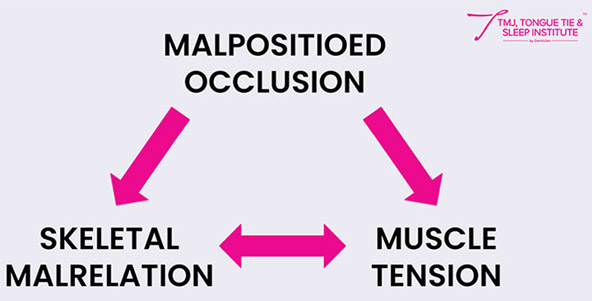
For our body to function properly, all the body parts should work in conjunction with each other. While diagnosing dental issues, especially when evaluating your bite or TMJ joint, it is necessary to check your body posture. It is essential because misaligned jaw joints or teeth can cause postural imbalance, and you should take prompt action to treat the condition.
Take the first step towards a pain-free life by unlocking the key to TMJ relief. Discover how your posture impacts your TMJ symptoms and explore effective treatment solutions
The connection between TMJ and Body Posture:
A human body posture represents a spatial relationship and structural balance between each component of the human body, including the head, neck, mandible, TMJ, occlusion, shoulders, back, pelvis, and legs. A strong relationship between the lower jaw position and body posture is found in 91 out of 95 i.e 95.8% of people. So, TMJ imbalance can cause a variety of conditions like forward head posture, neck and shoulder stiffness, back pain including short leg syndrome.
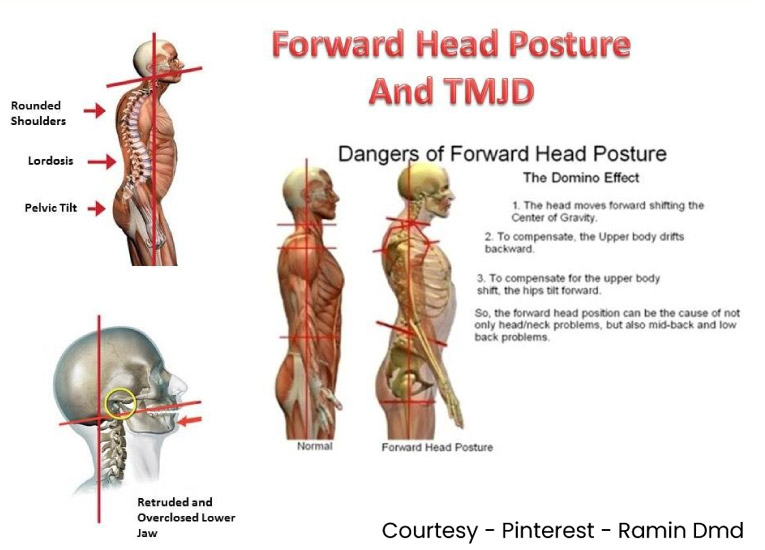
When a person has a malocclusion that is an incorrect bite, the resulting muscle tension and activity will cause your head to move forward into a forward head and neck posture, causing you to slouch and stiffen your neck muscles. This action will cause a domino effect down your body, putting stress on your face, neck, shoulder, and back muscles. This can cause one of your shoulders or hips to lift higher than the other.
Short leg syndrome is a condition in which a person has one short leg that may occur due to an imbalance in the jaw. When a jaw is imbalanced, it affects the shoulder, causing an imbalance in skeletal structure.This further leads to an imbalance in the hip. When a pelvis tilts forward, the hip rotates internally, which in turn results in internal rotation of the leg and foot. This causes the heel to move outwards. It describes how imbalance in one body component, here it is jaw can result in issues with your skeletal structure. This skeletal asymmetry also happens to be one of the causes of short leg syndrome.
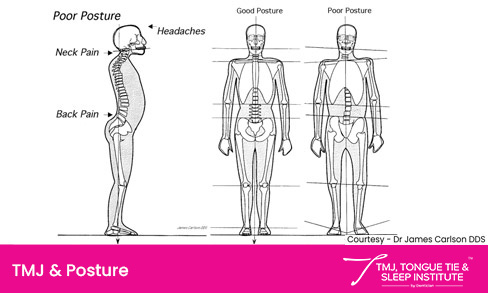
One of the treatments for correcting short leg syndrome caused due to TMD is by placing a GNM Orthotic to align your jaws which will in turn levels the shoulders and pelvis to put the feet in their natural position.
You must have noticed a pattern of how the imbalance starts at the top of your body and moves downwards, reverberating through the entire body, this is known as descending TMJ. Refer to our orofacial pain relief guide to learn more about descending TMJ.
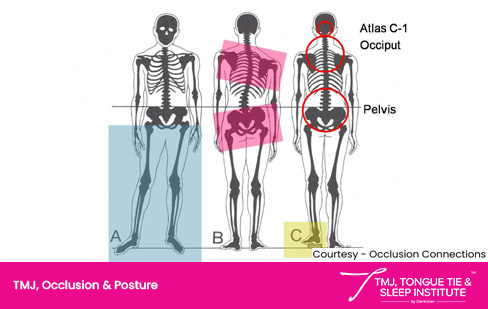
Understanding the symptoms of TMJ:
Keep in mind Temporo-mandibular disorders are primarily conditions that affect a combination of body components, including jaw muscles, head, neck, and hip, causing postural problems like:
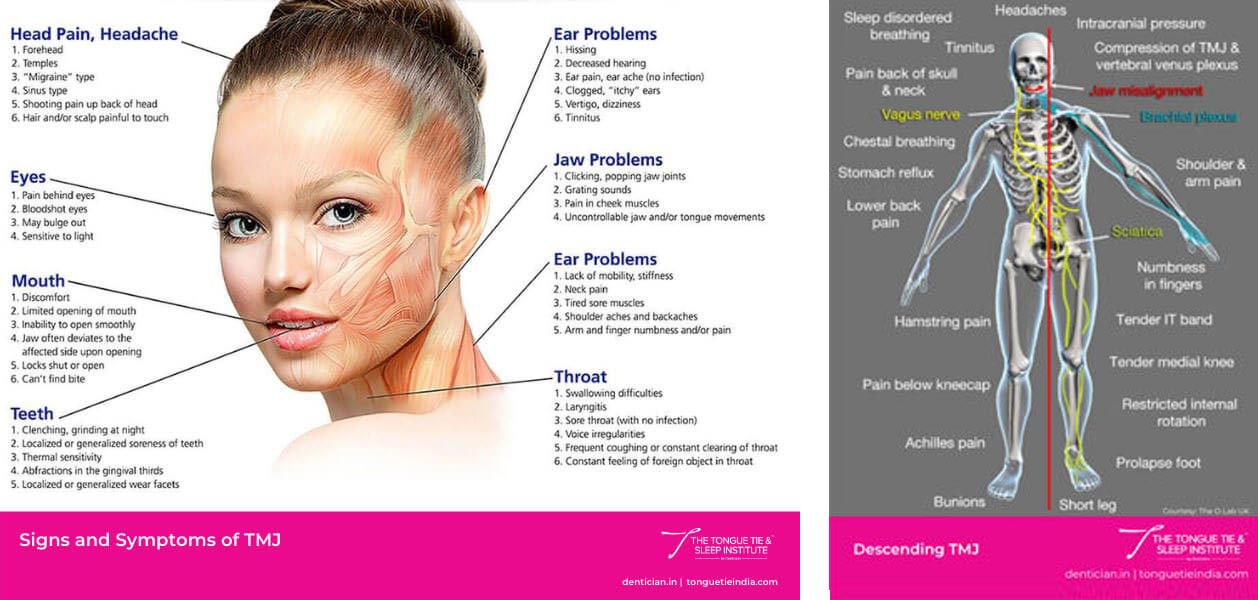
THE SYMPTOMS OF TMJ/TMD
Jaw Pain
Limited opening
Clicking or popping
Orofacial Pain
Jaw deviates when opening or closing
Headaches & Migraines
Back pain
Forward head and neck posture
Rolled shoulders
Incorrect Hip Alignments
One leg shorter than the other
Other common symptoms that occur due to the imbalance between bite and mandibular position include leg cramps, knee pain, sciatica, mid-back pain, and neck tension.
For a better understanding of the headaches, migraines, and TMJ disorder, you can refer to our informative guide about TMJ disorder.
To sum it up: Can a bad posture cause TMJ Disorder?
While bad posture does not directly cause a TMJ Disorder, it is a contributing factor. A bad posture can cause your head and neck to move in a forward position, which can affect your bite and temporomandibular joint, causing alignment problems and vice versa.
Due to the lack of awareness about TMJ Disorder, TMD patients are often misdiagnosed and do not receive proper treatment. Instead, when faced with patients who exhibit symptoms such as pain in the ear, feeling pressure in the ears, and ringing in the ear, all focused on one body part, the clinicians offer treatment based on the location of pain or symptoms. This often causes the patients to wander from specialist to specialist until they find a TMJ expert who’ll offer treatment for the same.
How can GNM Orthotics treat TMJ Disorder and Body Posture?
GNM, also known as Gnathic Neuromuscular Dentistry, is an advanced approach focusing on correcting TMJ pain, jaw alignment, body alignment and malocclusion to ensure optimal lower jaw and full body form and function.
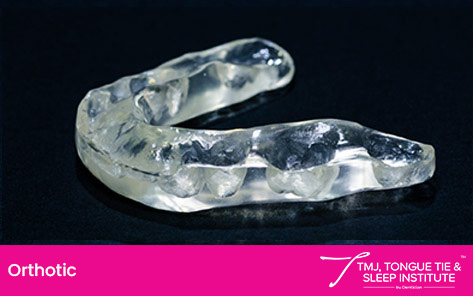
The appliances used as GNM orthotics for TMJ may look like any other TMJ Splints or TMJ mouthguards. But it implements both gnathologic and neuromuscular principles. The GNM approach and orthotic design cannot be compared by merely looking at the external (visual) features as there are other factors such as its physiologic inherent components that support optimal muscle balance, TM joint harmony, occlusal harmony and many other functional features that move physical dysfunctions to physiologic quality health and shifts functional impairments to an improved quality of life.
GNM orthotics can solve issues such as TM joint derangement, crossbite, anterior open bite, facial pain, headaches, pain experienced at the back of the head, shoulder tension, restricted head rotation, restricted mouth opening, one-sided deviation of the jaw, and clicking and popping in jaw joints and sleep apnea.
Patients interested in non-invasive methods of treating TMJ can look into Myofunctional therapy. Myofunctional therapy is a non-invasive method that can help patients by strengthening orofacial and tongue muscles. This helps stabilize your jaw and TMJ. It does a great job of relieving muscle tension.
Take the first step towards a pain-free life by unlocking the key to TMJ relief. Discover how your posture impacts your TMJ symptoms and explore effective treatment solutions
When Would You Need To Visit The Chiropractor?
A chiropractor is a healthcare provider similar to a physiotherapist that diagnoses & treats a patient’s bony & musculoskeletal problems.
For example,
If the patient is facing postural challenges such as upward head tilt posture, lower back pain or abnormal pelvic problem they’ll need to visit a qualified chiropractor.
A TMJ doctor and chiropractor can work together and rule out these factors. We encourage you to visit the TMJ, Tongue Tie and Sleep Institute in Mumbai, where you can get an accurate diagnosis and treatment for your TMJ disorder.
Related Blogs
Correlation between TMJ and Neck Pain
What Happens If TMJ Disorders are Left Untreated ?
Best and Worst Foods to Eat for TMJ Relief
Simple Jaw Exercises for Temporary Pain Relief from TMJ
Is my Anxiety, Stress & Tiredness Linked With My TMJ disorder?
Are You Struggling With Headaches, Migraines And TMJ Disorder?
